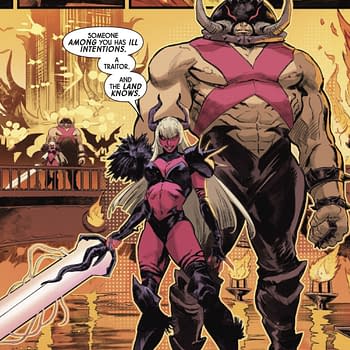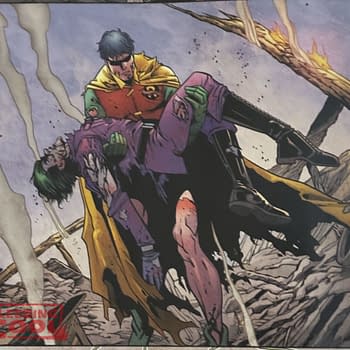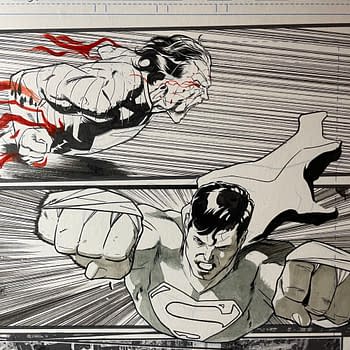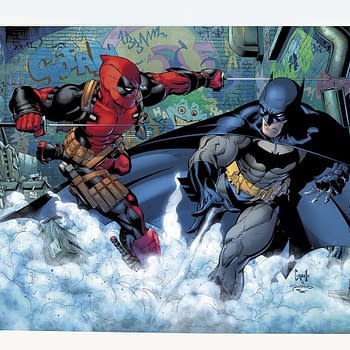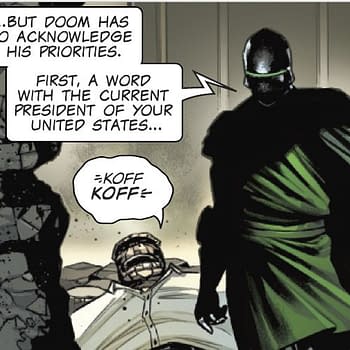Posted in: Comics, Recent Updates | Tagged: Comics, dan slott, entertainment, fantastic four, gardner fox, jack kirby, John Buscema, justice league, Madman Atomic Comics, matt fraction, mike allred, mike sekowsky, silver surfer, stan lee, steve ditko, superior spider-man, ty templeton
Cosmic Tones For Mental Therapy: Slott And Allred's Neo-Classical Silver Surfer Will Blow Your Mind
By Christopher Smith
Like many readers, I hotly anticipated Dan Slott and Mike Allred's Silver Surfer #1, released this week to considerable fanfare. I especially looked forward to the book not only to my being a fan of Slott's complex, manic, and shocking plotting on Superior Spider-Man (the Breaking Bad of superhero comics), but also quite fond of Allred's Madman and assorted other projects. While I have waited to dig into Allred and Matt Fraction's Fantastic Four in a collected edition, I couldn't resist jumping in to cruise the spaceways with Norrin Radd.
While some found the existential bent and general inner-space trippiness of Allred's most recently auteured Madman series, Madman Atomic Comics, excessive and self-indulgent, I recognize in it an attempt to do something genuinely new, a fusion of the idiosyncratic comics-as-philosophical-inquiry work of underground comix with a nostalgic love for the fun, truly bizarre, and vibrant world of Marvel circa 1965, when its ever-expanding universe bore a line-wide, knowing "Pop Art Productions" logo. Getting to know Allred creations like the Atomics helped the reader to understand just how bracingly weird characters like the Fantastic Four must have been to those accustomed to Gardner Fox and Mike Sekowsky's Justice League (which was, come to think of it, pretty weird itself).
[*Mild spoilers for Silver Surfer #1 below!]
But if Madman is a notable entry in the superhero-as-existential-voyager canon, the Silver Surfer's éminence grise—er, éminence métallisé—is the prototype for them all, a Christlike emissary haunted by his own power and dread-inspiring role as a herald of the world-devouring Galactus. A favorite of Stan Lee known for grandiose, and occasionally turgid, monologues on the state of man, the Surfer sought to reflect our own troubled humanity in his gleam. This makes Allred the perfect artist to return to one source among many for Madman, and Slott, too, who has been making a fascinating extended inquiry into villainy and heroism in Superior Spider-Man, promises to delve into this meaty moral conflict.
Of course, this wouldn't inspire so much enthusiasm from me if this wasn't a fun comic book. It's nice to know that Allred's personal vision holds up well in his recent Marvel work, and the lush, vibrant colors his partner Laura Allred are a treat unto themselves. Similarly, Slott lets go with several droll touches of humor, reminiscent of his own foray into Silver Age nostalgia in the 2005 Spider-Man/Human Torch he wrote with Ty Templeton as artist, which first brought his work to my attention. Slott cleverly echoes past Marvel tropes, as in his interesting inversion of the famous Dark Phoenix vs. the planet of asparagus people trope, when the denizens of Brundlebus 3 inspire the Surfer's mercy once he sees their gratitude at his rekindling of their sun.
Allred and Slott work a beautiful kind of synergy that makes the book a pop art masterpiece, from the cover font and design to the delicate, Romita-esque features of new character Dawn, who also promises to serve as reader surrogate as we travel the spaceways, and evoke the archetypal Doctor Who companion. Slott gives Dawn and her twin sister humorous quirks that evoke the great things he has done with the denizens of Peter Parker's (and now Otto Octavius') world in his tenure as a Spider-Man author.
As Hannah Means-Shannon has pointed out, the world of this comic is also uniquely compelling, and immersive. Its creative page layouts feature angular panels that vary in size. At times, its galactic backdrop shimmers in enlarged Ben-Day dot splendor, the power cosmic aglow with zip-a-tone bursts. Allred's stunning double-page rendition of the Impericon, and his tour through its Impossible Palace, manages to evoke the square root of Jack Kirby and Steve Ditko and yet is wholly its own. It's what has made him more than a charmingly nostalgic cover act, but one equal of his own psychedelic horizons.
Scanning the Surfer's very soul, the Motivator reflects the imagery of John Buscema's origin story featuring a pre-chrome Norrin Radd; the cover of issue #2 depicts the Never Queen, every bit the equal of Buscema's evil sorceresses during his time drawing Conan and Thor. This book pays tribute to what has gone before and yet charmingly, inventively, moves forward.
Reading it today (stone-cold sober as teetotaling Allred himself, scout's honor!) gives one an idea of what those Ditko Dr. Strange pages meant to the likes of Pink Floyd and Ken Kesey's Merry Pranksters. I can't wait to see where this book's writer and artist take us next.
Christopher Smith teaches composition at Columbus State Community College and has spent about two thirds of his life being obsessed with comics, music, and the strange, somewhat overlooked corners of pop culture. He lives with his wife, son, and two devious cats.














